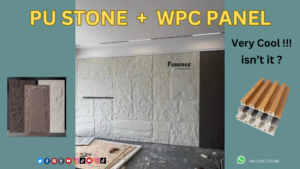The wall decoration trends for 2025 are expected to push boundaries by embracing sustainability, technology, and bold design. Here are some key trends to watch:
- Sustainable Materials: Eco-conscious choices will dominate the market, with an emphasis on biodegradable, recycled, and responsibly sourced materials. Wall panels made from bamboo, cork, or reclaimed wood will grow in popularity, alongside WPC (Wood Plastic Composite) and other eco-friendly materials.
- Smart Walls: Technology integration will be a significant trend, with walls designed to interact with smart home systems. These may include touch-sensitive panels, LED-embedded walls, or surfaces that can change color or texture through digital controls.
- 3D Wall Panels: 3D textures and geometric patterns will continue to gain traction. Expect bolder designs, like more pronounced fluting, deep grooves, and sculptural reliefs. Materials such as PU stone and acoustic panels will combine both aesthetics and functionality.
- Biophilic Design: Green walls and nature-inspired materials will remain strong. Indoor vertical gardens or moss panels will be incorporated into walls to bring an organic, calming element into modern interiors.
- Maximalism and Bold Colors: While minimalism has ruled for years, 2025 will see a resurgence of maximalism—vibrant colors, bold wallpapers, and intricate patterns will become more common. Large-scale murals or statement wall designs with dramatic contrasts and rich textures will be in vogue.
- Metallic Accents: Metallic wall finishes, such as gold, brass, and copper, will be used more creatively, often in geometric or abstract designs. Reflective or metallic surfaces will add a futuristic yet luxurious touch to interior spaces.
- Hybrid Wall Treatments: Combining multiple materials in a single wall treatment will become popular, such as blending natural stone with wood or metal accents. This mix-and-match approach adds dimension and interest.
- Textured Paint and Custom Finishes: Textured paints and custom plaster finishes like Venetian plaster will remain trendy, offering depth without the need for panels or other wall coverings. People will also opt for faux concrete, terrazzo, or stucco finishes for an industrial yet chic vibe.
These trends suggest that 2025 will focus on bold expression, customization, and the marriage of technology with design, all while maintaining a sustainable approach to interior decor.
2024 worldwide hot selling wall decoration materials
In 2024, several wall decoration materials are trending globally due to their aesthetic appeal, versatility, and alignment with modern design preferences. Here are some of the hot-selling wall decoration materials worldwide:
1. 3D Wall Panels (PU Stone, WPC Fluted Panels)
- Why it’s popular: 3D wall panels, particularly those made of PU stone and WPC (Wood Plastic Composite), are highly sought after for their texture and depth. They add a dynamic, visually interesting element to walls, creating a modern and stylish look.
- Example brands: FOROREE offers trendy 3D PU Stone Panels and WPC Fluted Wall Panels, which are in demand for both residential and commercial spaces.
2. Natural Stone & Marble
- Why it’s popular: Natural materials like marble and stone offer timeless elegance and are often associated with luxury. Faux marble options, such as PVC marble stickers (like FOROREE’s), offer a more affordable way to achieve the same look.
- Where it’s trending: Marble and stone designs are popular in high-end homes and commercial spaces across Europe, the Middle East, and Asia.
3. Wood and Wood-Look Panels
- Why it’s popular: Natural wood and wood-look panels are hot sellers due to their warmth and ability to fit into various design styles (from rustic to contemporary). WPC panels, which mimic wood, are especially popular for their durability and eco-friendliness.
- Where it’s trending: Wood panels are trending globally, particularly in the U.S., Scandinavia, and Japan where natural, warm aesthetics are appreciated.
4. Sustainable & Recycled Materials
- Why it’s popular: As eco-consciousness grows, there is increasing demand for sustainable materials. Recycled wood, bamboo panels, and biodegradable materials are gaining momentum.
- Where it’s trending: Particularly strong in Europe and North America, where consumers are prioritizing eco-friendly home improvement products.
5. Textured Paints and Plaster Finishes
- Why it’s popular: Textured paint and plaster finishes such as Venetian plaster or stucco are gaining popularity for their handcrafted, luxurious appeal. These finishes are customizable, allowing for a unique, artisanal look.
- Where it’s trending: This trend is prominent in Mediterranean, Middle Eastern, and Latin American markets.
6. Geometric and Metallic Wall Accents
- Why it’s popular: Metal wall panels or accents in gold, brass, and copper are highly fashionable for modern and industrial designs. Geometric designs using metallic finishes are popular in high-end interior design.
- Where it’s trending: Geometric and metallic designs are popular in urban centers, particularly in the U.S., UK, and the UAE.
7. Peel-and-Stick Wallpaper
- Why it’s popular: Peel-and-stick wallpaper is a best-seller thanks to its ease of use and variety of designs. This material allows for quick wall makeovers and comes in trendy patterns, textures, and faux finishes like brick, wood, and tile.
- Where it’s trending: Trending globally, especially in markets with a strong DIY culture like the U.S., UK, and Australia.
8. Acoustic Wall Panels
- Why it’s popular: Acoustic panels that combine soundproofing with stylish design are increasingly popular, particularly in home offices, media rooms, and public spaces. Many of these panels come in vibrant colors or with geometric designs, offering both function and form.
- Where it’s trending: Acoustic panels are hot sellers in urban areas worldwide where noise control is a concern, especially in the U.S., Europe, and Asia.
PU stone panel and WPC flute panel features and advantages ?
Both PU (Polyurethane) stone panels and WPC (Wood Plastic Composite) fluted panels are popular choices for wall decoration due to their versatility, durability, and aesthetic appeal. Here are the features and advantages of each:
PU Stone Panels
Features:
- Material: Made from high-density polyurethane, PU stone panels are designed to mimic the appearance of natural stone.
- Lightweight: They are much lighter than real stone, making them easier to handle and install.
- Variety of Designs: PU panels are available in various textures, colors, and patterns, often mimicking stone, brick, or other natural materials.
- Durable: Resistant to cracking, warping, and other damage that natural stone might suffer from in harsh conditions.
- Waterproof & Moisture-Resistant: Ideal for use in areas with high humidity like bathrooms or kitchens.
- Thermal Insulation: PU panels offer some level of thermal insulation, helping to regulate indoor temperatures.
- Low Maintenance: They don’t require sealing, painting, or regular upkeep like real stone.
Advantages:
- Easy Installation: PU stone panels are lightweight and can be installed using adhesives or screws, reducing labor time and costs.
- Cost-Effective: They offer the luxurious look of stone at a fraction of the cost.
- Versatile Applications: Suitable for both indoor and outdoor use, making them a versatile choice for walls, facades, and feature walls.
- Energy Efficient: Their insulation properties can help reduce heating and cooling costs.
- Durability: They are long-lasting and resistant to weathering, making them great for outdoor settings as well.
WPC Fluted Panels
Features:
- Material: WPC panels are made from a composite of wood fibers and plastic, combining the natural look of wood with the durability of plastic.
- Textured Design: These panels often feature fluted or grooved designs, adding texture and dimension to walls.
- Eco-Friendly: WPC is often made from recycled materials, making it an environmentally sustainable option.
- Water-Resistant: WPC panels are highly resistant to moisture, making them ideal for humid environments.
- Durable: Resistant to termites, rot, and decay, unlike natural wood.
- UV Resistant: Some WPC panels are UV-resistant, ensuring they won’t fade or degrade in direct sunlight.
- Low Maintenance: They require little maintenance compared to natural wood panels.
Advantages:
- Sustainable Choice: WPC is a green product, often using recycled materials and reducing the need for natural wood.
- Durability: Highly resistant to weather, moisture, and pests, making it suitable for both indoor and outdoor applications.
- Aesthetic Appeal: Fluted panels provide a modern, sleek appearance with rich textures that can elevate the look of any space.
- Easy Installation: Like PU panels, WPC fluted panels are relatively easy to install with basic tools and adhesives.
- Variety: Available in a wide range of colors, finishes, and styles, allowing for design flexibility.
- Fire Resistance: Many WPC panels come with fire-resistant properties, adding safety to their list of benefits.
Comparison: PU Stone Panels vs. WPC Fluted Panels
- Aesthetic Appeal: PU stone panels provide a classic, rustic look that mimics natural stone, while WPC fluted panels offer a sleek, modern finish with grooved textures.
- Applications: PU stone panels are ideal for spaces where a natural stone look is desired, both indoors and outdoors. WPC fluted panels are typically used indoors for accent walls, ceilings, and feature walls, and are also a good option for moisture-prone areas like bathrooms.
- Installation: Both panels are lightweight and easy to install, though PU stone panels may require more attention to create a seamless “natural” look, while WPC panels are often easier to fit and align.
Does PU stone and WPC panel manufacturer is from same area ?
Does pu stone and wpc panel manufacturer can be found in the same city ?!
PU stone panel and WPC (Wood Plastic Composite) panel manufacturers are often located in similar regions, especially in countries with well-established industries for building materials, but they are not necessarily from the same area. Here’s a breakdown:
Geographic Locations of Manufacturers
- China:
- China is a major global producer of both PU stone panels and WPC panels. Many manufacturers of these products are based in industrial regions such as Guangdong, Zhejiang, Jiangsu, and Shandong provinces.
- Guangdong Province is well-known for producing a wide range of building materials, including both PU and WPC panels.
- Zhejiang Province(haining, such like FOROREE) and Shandong Province are also key regions for manufacturing WPC panels due to their large-scale wood-plastic composite production industries.
- China is a major global producer of both PU stone panels and WPC panels. Many manufacturers of these products are based in industrial regions such as Guangdong, Zhejiang, Jiangsu, and Shandong provinces.
- India:
- India has also become a growing market for WPC production, though PU stone panels are less commonly produced there. Manufacturers are often located in Gujarat, Maharashtra, and Delhi NCR.
- Turkey:
- Turkey has a strong building material industry and produces both PU stone panels and WPC products. The country’s proximity to Europe makes it a strategic supplier to the European market.
- European Countries:
- In Europe, countries like Germany and Italy have manufacturers that produce WPC panels, though PU stone panels are less common. They focus more on sustainable materials and high-quality composites.
- United States:
- There are manufacturers of WPC panels in the U.S., primarily catering to decking and outdoor wall cladding markets. PU stone panels are typically imported, but some local manufacturers focus on architectural faux stone products.
Overlap of PU and WPC Panel Manufacturers:
- Same Factories: Some manufacturers may produce both PU stone and WPC panels because they serve the same market niche in wall decoration and architectural finishes. These manufacturers typically have the machinery and expertise to work with multiple types of synthetic or composite materials.
- Different Factories: In other cases, PU stone panel and WPC panel manufacturers can be from different facilities or regions, especially if they specialize in one type of material.
Conclusion:
Manufacturers of PU stone panels and WPC panels may come from the same general areas, especially in countries like China, where the building material industry is clustered in certain provinces. However, they may not always come from the same specific factory or industrial park, as they involve different production processes and expertise. If you are sourcing both types of products, it is possible to find suppliers in similar regions, especially in China. contact FOROREE for gethering them. hello@FOROREE.com, W.a:+8619817731588




